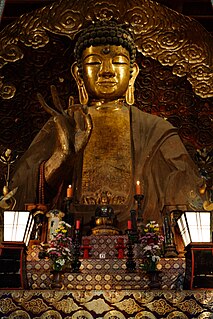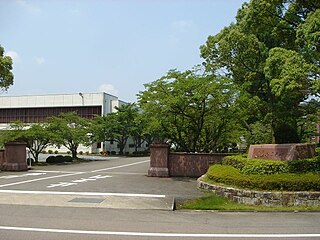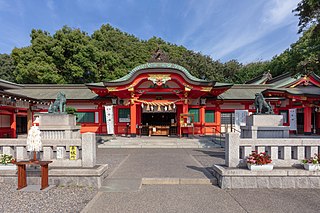 W
WThe Eizō & Tōichi Katō Memorial Art Museum is a museum located in Gifu Park in the city of Gifu, Gifu Prefecture, Japan. It is dedicated to the works of the brothers Eizō and Tōichi Katō, who were born in the city. It is part of the Gifu City Museum of History.
 W
WGifu Castle is a Japanese castle located in the city of Gifu, Gifu Prefecture, Japan. Along with Mount Kinka and the Nagara River, it is one of the main symbols of the city. The caste is also known as Inabayama Castle . It was designated a National Historic Site in 2011.
 W
WThe Gifu City Museum of History is a city-supported history museum located in the city of Gifu, Gifu Prefecture, Japan. Located in Gifu Park at the base of Mount Kinka, it is in the heart of Gifu City's sightseeing area.
 W
WGifu City Women's College is a public college in the city of Gifu, Gifu Prefecture, Japan, founded in 1946. Its abbreviated name is Gijotan (岐女短).
 W
WGifu Gokoku Shrine is a Shinto shrine located at the base of Mount Kinka in Gifu, Gifu Prefecture, Japan. The shrine is dedicated to the 37,000 residents of Gifu Prefecture who have died in wars since the Meiji Restoration. Official ceremonies are also held at the neighboring Hotel Seiran, which is part of the shrine facilities.
 W
WThe Gifu Great Buddha is a large Buddhist statue located in Shōhō-ji in Gifu City, Gifu Prefecture, Japan. It was conceived by the 11th head priest of Kinpouzan Shōhō temple, Ichyuu, around 1790, in hopes of averting large earthquakes and famines. Ichyuu died in 1815 before it was completed, but his successor, Priest Kohshuu completed it in April 1832, after 38 years of construction. It is one of the three great Buddha portrait statues in Japan.
 W
WThe Gifu Mosque or Bab al-Islam Gifu Mosque is a mosque in Gifu City, Gifu Prefecture, Japan. It is the first mosque in the prefecture.
 W
WGifu Pharmaceutical University is a municipal university located in the city of Gifu, Gifu Prefecture, Japan. The predecessor of the school was founded in 1932, and it was chartered as a university in 1949.
 W
WGifu Shotoku Gakuen University is a private university in the city of Gifu, Gifu Prefecture, Japan.
 W
WGifu Station is a railway station in the heart of the city of Gifu, Gifu Prefecture, Japan, operated by Central Japan Railway Company.
 W
WGifu University is a national university in the city of Gifu, Gifu Prefecture, Japan. It is sometimes abbreviated as Gidai (岐大) or Gifudai (岐阜大).
 W
WGifu Women's University is a four-year private university in the city of Gifu, Gifu Prefecture, Japan, and was founded in 1968. Its name is abbreviated as Gifu Joshi Dai (岐阜女子大) or G.W.U.
 W
WHokke-ji (法華寺) is a Buddhist temple of the Shingon school located in Gifu, Gifu Prefecture, Japan. Though its formal name is Hokke-ji, it is more well known by its unofficial name, Mitahora Kōbō (三田洞弘法).
 W
WHonjō Shrine is a Shinto shrine located in Gifu, Gifu Prefecture, Japan. Alternative kanji for the shrine are 本庄神社. Honjō Shrine was built as a larger shrine, but it was split into three separate shrines, of which the current Honjō Shrine is one. The other two are Yakumo Shrine and Rokujō Shrine, both of which are located nearby.
 W
WInaba Shrine is a Shinto shrine located at the base of Mount Kinka in Gifu, Gifu Prefecture, Japan. Originally, its name was written 稲葉神社, which is pronounced the same way. It is the main shrine that is celebrated by the city of Gifu in its annual Gifu Festival on the first Saturday of each April. Because of its size, it is a popular spot for hatsumōde and Shichi-Go-San.
 W
WJōzai-ji (常在寺) is a Buddhist temple of the Nichiren sect in Gifu, Gifu Prefecture, Japan. Its formal name is Shūrinzan Jōzai-ji (鷲林山常在寺). Starting with Saitō Dōsan, Jōzai-ji served as the family temple for the Saitō family for three generations, which included his son, Saitō Yoshitatsu, and his grandson, Saitō Tokugen. Also, it has been designated as a nationally Important Cultural Property, as it contains pictures of both Dōsan and Yoshitatsu.
 W
WKanō Castle was a hirajirō-style Japanese castle located in the city of Gifu, Gifu Prefecture, Japan. It was one of the few castles built after the Battle of Sekigahara and establishment of the Tokugawa shogunate and was used as an administrative center of Kanō Domain under the end of the Edo period, but only its ruins, including the base of the tenshu and stone walls, remain today. The ruins were designated National Historic Site in 1983.
 W
WKanō Tenman-gū (加納天満宮) is a Shinto shrine located in the city of Gifu, Gifu Prefecture, Japan. It was built as the shrine to protect Izumii Castle. As a Tenman-gū, it is dedicated to Tenjin, the deified form of Sugawara no Michizane. Additionally, Matsudaira Mitsushige, who first created Gifu Umbrellas, is also canonized on the shrine grounds. The shrine's festival is held on the third Saturday and Sunday of October each year.
 W
WKashimori Shrine is a Shinto shrine located in the city of Gifu, Gifu Prefecture, Japan. From long ago, it has been considered a good place for married couples and children to go for good luck. One legend associated with Kashimori Shrine is that when Tenma, a mythical horse, landed behind the shrine, it left a hoof print in stone that can still be seen today. Each year, on April 5, the shrine hosts the Gifu Festival, along with Inaba Shrine and Kogane Shrine.
 W
WKogane Shrine is a Shinto shrine located in the city of Gifu, Gifu Prefecture, Japan. First built in 135, it has long been considered a place to pray for financial blessings. Because it is located near the city center, approximately 150,000 worshippers visit the shrine over the three-day New Year's period. On April 5, the shrine hosts the Gifu Festival with Inaba Shrine and Kashimori Shrine. The nearby Kogane Hall can be used as a communications place for the citizens of the city.
 W
WThe Museum of Fine Arts, Gifu is art museum located in the city of Gifu, Gifu Prefecture, Japan. The focus of the museum is on art and artists related to Gifu Prefecture, but the museum also collects pieces from other places in Japan and overseas.
 W
WNagara Tenjin Shrine is a Shinto shrine located in the Nagara area of Gifu, Gifu Prefecture, Japan. It is a Tenman-gū dedicated to the worship of Sugawara no Michizane.
 W
WThe Nawa Insect Museum is a museum in the city of Gifu, Gifu Prefecture, Japan. It is operated by the Nawa Insect Research Center.
 W
WNishi-Gifu Station is a railway station operated by Central Japan Railway Company and is located in the western part of the city of Gifu, Gifu Prefecture, Japan.
 W
WShōhō-ji (正法寺) is a Buddhist temple of the Ōbaku school of Buddhism in Gifu, Gifu Prefecture, Japan. It is a branch temple of Mampuku-ji in Uji, Kyoto Prefecture. The temple has many aspects of the Ōbaku school, but its building style and sacraments are in the Chinese style. Additionally, it is much larger than the average Japanese temple. The temple's official name is Kinpōzan Shōhō-ji (金鳳山正法寺).
 W
WSōfuku-ji (崇福寺) is a Buddhist temple located in Gifu, Gifu Prefecture, Japan. The temple has strong ties to both Saitō Dōsan and Oda Nobunaga. Gifu's Sōfuku-ji is famed throughout Japan for both the number of monks it produces and for its "Blood Ceiling". Shortly after its founding, it was also known as Kōsai-ji (弘済寺), but that name is no longer used. It is also one of the Mino Thirty-three Kannon.
 W
WTejikarao Shrine is a Shinto shrine located in the city of Gifu, Gifu Prefecture, Japan.